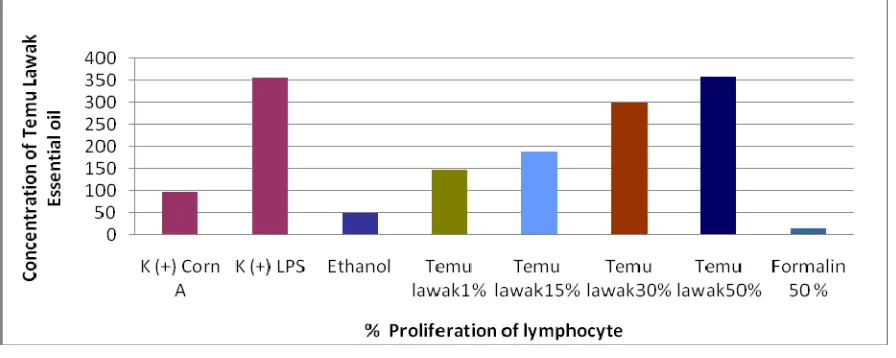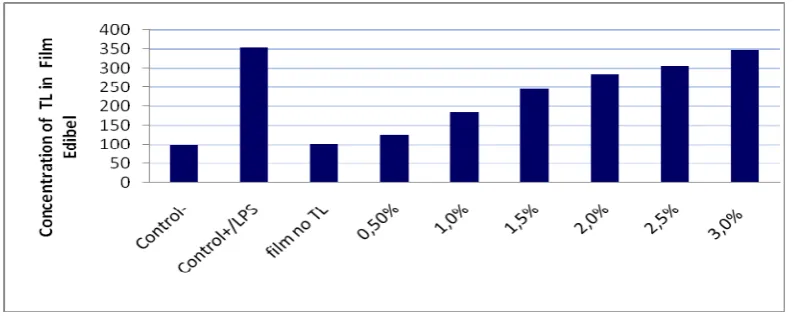Lymphocyte Proliferation by Temu Lawak (
Curcuma xanthorrhiza
ROXB)
Essential Oil
Miksusanti
Chemistry Program, Faculty of Mathematic and Science, University of Sriwijaya
E-mail address: ati_mik@yahoo.com
Abstract
. This study demonstrated that Temu lawak essential oil have potential to proliferate human lymphocyte. This study use essential oil of Curcuma xanthorrhiza from Lahat South Sumatra. Essential oil were extracted from Temu lawak tuber by vapor distillation. Lymphocyte were extracted from human blood. Human lymphocyte were released by flushing the spleens several times with RPMI 1640 medium in test tube. Essential oil was dissolved in ethanol. Increasing concentration of Temu lawak essential oil resulted in greater activation of lymphocyte. Lymphocyte proliferation by free essential oil were in a range 146,55-356,66% and by immobilized essential oil were 126,32- 348,11%.Key words: Human lymphocyte, lymphocyte proliferation, temu lawak essential oil
1.Introduction
The used of medicinal plants to cure human illnesses has been practiced from time immemorial. Some of these drugs are believed to enhance the natural resistance of the body to infection. In fact, one of the therapeutic strategies in Ayurvedic medicine is to provide protection by increasing body’s resistance to decrease (Atal. 1986). The concept of immunomodulation relates to a non-specific activation of the immune system. It implies primarily a non-antigen dependent stimulation of the function and efficiency of macrophages, granulocytes, complement, natural killer cells, lymphocytes and also the production of various effectors molecules by activated cells (Para immunity). Being non-specific, it is expected to give protection against different pathogens including bacteria, fungi, viruses etc and constitutes an alternative or adjunct to conventional chemotherapy.
Lymphocytes is an adaptive immune system. Lymphocytes consist of B lymphocyte and T lymphocytes. Mature lymphocytes enter the bloodstream; specific receptors enable adherence to capillary endothelial cells and migration into peripheral lymphoid organs (Raga et al.2004).
The objectives of this work were to investigate and characterize the expansion of lymphocytes from healthy individuals, cultured in presence of essential oil of Temu lawak tuber, using the expansion induced by LPS, and Con A as control references. The ability of these essential oil used at different concentrations to induce in vitro lymphocytes proliferation was tested using human lymphocytes. The present study is aimed at studying the lymphocyte activation properties of Temu lawak oil. As a complementary study, main constituents of the essential oil of Temu lawak tuber were detected by gas chromatography combined with mass spectrometry (GC-MS).
2.Methodology
2.1. Extraction of the essential oils
dried over anhydrous sodium sulfate. The yield of the essential oil produced during steam distillation was 3 %. (v/w), and 2 μl was used for GC -MS measurements (Naz Shgufta et al.2010).
2.2. Gas chromatography/mass spectrometry (GC/MS) analysis of essential
oils from Temu lawak Tuber
GC-MS analyses were carried out using an HP-5890 gas chromatograph coupled with a Finnigan MAT 800 ion Trap detector a J&W DB-1 column (30x0.25 film thickness 0.25 μm) was used with helium as carrier gas (linear velocity 30 cm/s). The temperature programming was performed as follows: 60oC isothermal for 10 min then increased from 60oC to 220oC at 4oC/min and finally isothermal at 220oC for 5 min. The injector temperatures were 250oC. The EI/MS spectra were recorded at 70 eV (ion source temperature: 220oC). The mass range was 35 to 425 m/z. The essential oil components were identified on the basis of their mass data and the comparison of their relative retention index (RRI). Their EI-mass spectra were either compared with the NIST/NBS and Wiley library spectra found in the literature or were confirmed by comparison with data published in a reference book (Devaraj et al.2010).
2.3. Lymphocyte isolation and culture
Human lymphocytes were obtained under sterilized conditions from human male B blood type. Ten milliliters of peripheral blood were obtained from each patient and collected in sterile tubes containing heparin. The blood were immersed immediately into 25 mM HEPES (N-2-hydroxyethyl-N’-1-sulfoethyl–piperazine)-buffered RPMI 1640 medium. The lymphocytes were released by flushing the spleens several times with RPMI 1640 medium using a 10 mL disposable plastic syringe fitted with a 26-gauge needle. The lymphocyte suspension was filtered through a
70-μm mesh nylon net to remove debris, and centrifuged at 200g for 5 min at room temperature. The lymphocyte pellets were than mixed gently with Tris-buffered 0.8% (w/w) NH4CL to lyses contamination erythrocytes and washed twice with RPMI 1640 medium. Cells (2 x 105/mL) were cultured in sterile vials containing 2.5 mL of RPMI-1640, 10% of bovine fetal serum and 1% of antibiotics (100 μg/mL streptomycin and 100 μg/mL ampicyllin). Cultures were stimulated with 0.25 mL of different mitogens: 10 μg/mL lectin from Phytolacca Americana (ConA) (Sigma St.Louis,US), 10 μg/mL phytohemaglutinina (LPS) (Sigma, St.Louis, US) (Pereyra et al.2005).
The number of lymphocytes in the suspension was counted using microscope. The cell were adjusted to the desired cell concentration by addition of 25 mM HEPES-buffered RPMI 1640 medium. To determine the effect of Temu lawak essential oil the certain amount of lymphocytes were plated in 96-well tissue culture plates. All culture were incubated in incubator with condition 5% CO2, 37oC and RH 90% for 3x24 hours. Different concentration of Curcuma xanthorrhiza
essential oil were added to each well in triplicate. Four hours before incubation time finish, the culture were added 10 μL solution of tetrazolium (MTT), and incubation was continued. After incubation time were finished HCL and isopropanol were added into each well. lymphocyte proliferative responses were determined using ELISA READER with MTT method and the datum were compromised with microscopic data. Celluler expansion induced by mitogens was compared with the one induced essential oil of Temu lawak tuber (Hidenori et al.2006).
2.4. Dissolve of immobilized essential oil
Essential oil that immobilized in uwi starch edible film were cut into small pieces and dissolve in ethanol 80%. The solution were shaked for 24 h. The ethanol were evaporated with vacuums evaporator and temperature 30oC.
2.5. Statistical analysis
3. Result and Discussion
Essential or volatile oils are products of intense fragrance, extracted from aromatic plants. Although they are mainly used in food and cosmetic industry, many of them have other tested activities such as antimicrobial and antioxidant properties. Numerous investigations report antiviral, antioxidant and antibacterial activity of terpenoids substances present in the essential oil fraction, extracted from aromatic plants.
Temu lawak (Curcuma xanthorrhiza) essentialoil is vapor distillation from the dried tuber of the plant. This tuber has been used in Indonesian as traditional medicine for various therapeutic purposes such as anti-hypertensive, anti-rheumatic, antioxidant and anti-inflammatory etc (Lim C.S
et al.20005). In our research, we have isolated a volatile fraction of Temu lawak tubers by hydro-distillation. In our preliminary studies it has been found that Temu lawak tubers oil inhibited the growth of a wide variety of bacteria and fungi in vitro.
In this research we found that essential oil of Temu lawak induce higher proliferation rates than non stimulated cultures (p<0.05). Temu lawak essential oil showed mitogenic activity similar to LPS and higher than ConA. A significant difference was found between proliferation rates induced by LPS and Con A compare to 1% - 50% proliferation rates by free and immobilized temu lawak essential oil (figure 2).
Essential oil derived from Temu lawak tuber induced colony formation in number similar to conventional mitogens and higher to non stimulated cultures (p< 0.05). Cellular proliferation rates, induced by the conventional mitogens tested, were considered little cluster in all cases. There were some few and little lymphocyte cluster in some slides from the non stimulated cultures observed. Addition Con A, and LPS induced rather small colony formation in all slides. Similar result were
found when using Temu lawak essential oil as stimuli. Total area of lymphocyte colonies was count from microscopic analyses with hemasytometer apparatus.
Increases in the Temu lawak essential oil concentration in serial sample caused increasing in lymphocyte activation. Treatment with 0.5 - 3% Temu lawak essential oil significantly increased the lymphocyte proliferation compared to control K-(100) and K+/LPS (354,85). Significantly increased of lymphocyte observed when the sample treated with essential oil compared to control negative. By treatment with ethanol alone, lymphocyte proliferation decrease compared to control, either control (+) nor control (-) /standard. Treatment with highest concentration, in this serial concentration of essential oil can activate lymphocyte higher significantly (146,55-356,66) (P<0.05).
Both Free essential oil and immobilized essential oil, can activate lymphocyte proliferation. Both data was showed significantly different in lymphocyte proliferation (P<0.05).
Curcuma xanthorrhiza essential oil is placed among non-toxic vegetal drugs that are authorized for their use with medicinal purposes. Devaraj et al (2010) has studied the toxic effect of Temu lawak etanol extraction over mice, demonstrating that those extract did not show any toxic effect in mice at 5g/kg.
Gas chromatography revealed the presence of camphor 4,64%, zingibere 2,26%, germacratriene 2,13%, beta fernasene 3,64, alpha curcumene 25,99%, furanodiene 5,21%, alpha cedrene 32,71, dehidroandrostenedione 3,02%, germacrone 1,37%, and alpha chamigrene 14,22% as the other terpenoids compounds and it’s derivative in lower quantities in temu lawak essential oil. Some of these could be responsible for the compound’s biological activity (Mahmood, MK et al. 2004). In the near future we’ll evaluate the potential of immunomodulating activity on human lymphocytes of each identified constituent separately to all chemical composition of the essential oil that has not been studied yet. However, considering water and heat as extraction agent and factor, we assume that biological activity of the essential oil is due to semi hydrosoluble-thermosetting substances as terpenoids or short chain hydrocarbon and it’s derivative.
4. Conclution and Sugestion
According to our results, we can concluded that essential oil derived from Temu lawak tuber showed excellent in vitro mitogenic activity and could be used as alternative non-toxic mitogens reagents in diagnostic assessment of cellular immunity. Essential oil of Temu lawak tuber at concentration equal or lower than 0.5% v/v and 3% v/v respectively, will be studied in order to assess their potential ability for stimulate Ig of immune cell and vegetable constituents will be carried out to assess the potential of each single compound to stimulate lymphocyte proliferation.
5.Acknoledgements
6.References
Atal CK. 1986. Role of some important Ayurvedic drugs in modulating the immune sytem in the human body. Indian drugs Manufacturer’s Association Bulletin, 16, 17-30.
Devaraj Sutha et al.2010. Evaluation of the Antinociceptive activity and Acute Oral Toxicity of Standardized Ethanolic Extract of the Rhizome of Curcuma xanthorrhiza Roxb. Molecule, 15,2925-2934.
Lim C,S et al. 2005, Antioxidant and anti-inflammatory activities of xanthorrhizol in hipppcampol neurons and primary cultured microglia. J.Neurosci.Res, 82,831-838.
Naz Shgufta et al.2010. Antibacterial Activity of Curcuma Longa Varieties Against Different Starins of Bacteria, Pak J.Bot, 42(1): 455-462.
Ganju, Karan D, Chanda S. 2003.Immunomodulatory effects of agents of plant origin. Biomed Pahrmacother; 57:296-300.
Hidenory O, Takeshi I, Teruno O, Kazumori K. 2006. Activation of Lymphocyte Proliferation by Boronate-Containing Polymer Immobilized on Substrate:The effect of Boron content on Lymphocyte proliferation, European Cells and Materials, 12, 36-43.
Mahmood, MK et al. 2004, Analgesic and Antidiuretic of Curcuma xanthorriza, J.Pharm Sci, 3, 1-2.
Raga-inskiene O, Gailys V, Jankauskiene K, et al.2004.Common perilla (Perilla frutescens [L] Britton) as a perspective immunomodulator Medicine (Kaunas) 40(3):220-224.
Pereyra MLG, Cariddi LN, Ybarra F, Isola MC, Demo MS, Sabini L. Maldonado AM. 2005. Immunomodulating properties of Minthostachys verticillata on human lymphocytes and basophils. Revista Alergia Mexico 5; 52 (3):105-112.

